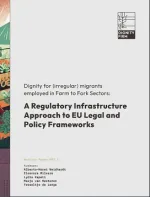A regulatory infrastructure approach to EU legal and policy frameworks

DignityFIRM Working Paper WP3.1 (2023)
Migrant workers, including those with irregular status, are essential to the European Union’s (EU) economies, particularly to food sectors and industries. Yet, irregular migrant workers face structural obstacles in accessing decent working conditions and essential services. The DignityFIRM project focuses on identifying vulnerabilities and improving working conditions and access to services by exploring and throwing light on dynamics of irregularity in upstream (agriculture and food processing) and downstream (hospitality and food delivery) aspects of Farm to Fork (F2F) supply chains. Avoiding policy siloes and disciplinary boundaries, this Working Paper maps EU-level legislative and policy frameworks across four crucial domains: migration management, the European Pillar of Social Rights – with a focus on public health policies – the EU’s F2F strategy, and corporate social responsibility. It is our presumption that these policies collectively shape the conditions and vulnerabilities of irregular migrant workers. This will be empirically tested in other DignityFIRM research activities.
The Working Paper describes these four policy domains and underlying EU frameworks not in isolation but as interconnected components of a broader ‘regulatory infrastructure’. This infrastructure comprises not only legal and policy dimensions, but also economic and commercial considerations and actors, social structures, and technological factors. These interconnected elements impact irregularity in various ways across the different labour sectors examined. The Paper covers multiple frameworks in these four domains, including some, as the Seasonal Workers Directive, that specifically concern F2F sectors. However, it starts off by discussing the limitations of the binary approach to irregularity embedded in EU law. This binary approach is best illustrated in the Return Directive and the Employers Sanctions Directive, which categorise migrants as either staying “legally” or “illegally” based on their residence status. By contrast, the Paper highlights the complexity of irregularity, which goes beyond this simple binary distinction, demonstrating how different frameworks and factors interact to create a multi-dimensional process of irregularity. The Paper identifies three concrete scenarios in particular that reflect this multi-dimensional process and generate discrepancies and vulnerabilities: i) status-based irregularity: this scenario involves individuals who have the right to reside in an EU Member State but either have no right to work or face restricted access to employment there, as in the case, for example, of asylum seekers or international students; ii) temporal irregularity: individuals can transition between regular and irregular statuses. This can happen when visas expire, people lose their jobs, or asylum seekers lose their (temporary) residence status. Yet, access to work may also facilitate a return to residence status for those who have lost it; iii) territorial irregularity: in this scenario, a person has the right to stay and work in one Member State but has irregular status or restricted access to work in another Member State, as, for example, asylum seekers or refugees moving irregularly to a Member State different from that responsible for their protection. These three scenarios highlight the diverse and changing nature of irregularity and the associated risks of exploitation. This is also illustrated by the dynamics of irregularity which mobile EU citizens who engage in informal work in other Member States also face, which this Paper also covers.